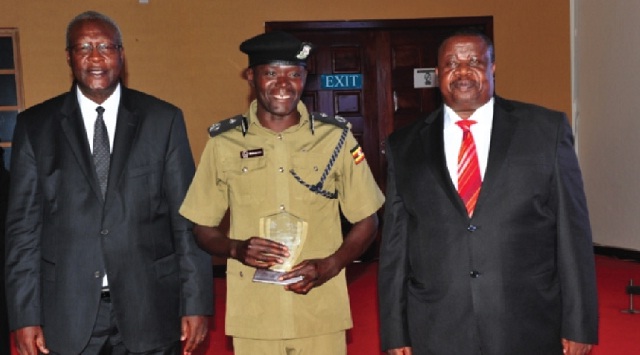
Implementation of the fourth strategic plan is empowering people to build trust and uphold rights
Kampala, Uganda | THE INDEPENDENT | The Justice, Law and Order Sector (JLOS) has implemented three strategic plans in the past 15 years and one major issue that has stood out is; the formation and stabilization of the sector. In order to build on this stability, JLOS is at the moment executing its fourth Sector Development Plan – SDPIV (2017-2020).
SPECIAL PROJECT: Below a JLOS three-year strategic plan
****
The plan is designed to ensure that people in Uganda live in a safe and just society, in line with the aspirations of Uganda’s Vision 2040 and the National Development Plan II.
Essentially, the strategy aims at promoting the rule of law. It is prioritizing interventions in the following areas; widening and deepening access to services of JLOS institutions; eliminating case backlog; addressing the wider civil and criminal justice challenges; development and funding of special programmes to target gender, age, poverty and other forms of vulnerability; mainstreaming national priorities and the Sustainable Development Goals (SDGs); tackling the growing concerns of corruption and human rights violations; and strengthening the environment for competitiveness.
JLOS Institutions
The JLOS sector brings together 18 institutions responsible for administering justice, maintaining law and order, and promoting the observance of human rights. The sector also brings together state and non-state actors who play complementary roles in planning, budgeting, programme implementation, monitoring and evaluation.
The state institutions responsible for administering justice, maintaining law and order and promoting the observance of human rights include; Ministry of Justice and Constitutional Affairs (MoJCA); Judiciary; Ministry of Internal Affairs (MIA); Directorate of Citizenship and Immigration Control (DCIC); Office of the Director of Public Prosecutions (DPP); Uganda Police Force (UPF); Uganda Prison Service (UPS); Judicial Service Commission (JSC); Law Development Centre (LDC); Ministry of Gender, Labour and Social Development (MoGLSD)-Gender, Justice for Children, Labour and Probation Functions; Ministry of Local Government (MoLG)-Local Council Courts; Tax Appeals Tribunal (TAT); Uganda Human Rights Commission (UHRC); Uganda Law Reform Commission (ULRC); Uganda Law Society (ULS); Centre for Arbitration and Dispute Resolution (CADER); Uganda Registration Services Bureau (URSB) and the National Identification and Registration Authority (NIRA).
The non-state actors including; development partners, academia, CSOs, media and private sector groups complement Government in the delivery of justice, law and order and advocacy for adherence to human rights.

Achievements
Important to note is that the good collaboration amongst these institutions, over the four years specifically has yielded tangible results. For instance, there has been an increase in public trust, increased stakeholder engagement, awareness and higher satisfaction by the people who seek services from JLOS institutions. In the past five years, public confidence in JLOS institutions increased from 26% in 2012 to 48% in 2016, and Public knowledge about JLOS institutions increased to 90% on average in 2015/16.
The level of satisfaction attained by those that received JLOS services rose from an average of 59% in 2012 to 72% in 2016. The Index of Judicial Independence grew by 22% from 2.8 in 2014 to 3.14 in 2016. In addition, the sector was able to ensure that unified JLOS services are available in more districts than in the year 2000 and 82% of the population were traversing shorter distances to access services. The sector is also functionally present in 82% of districts as compared to 65% in 2012/13 and 59.8% of districts in 2015/16 have a complete chain of JLOS services as compared to 53% in 2014/15.
The crime rate reduced during the SIPIII period from 298 per 100,000 in 2014 to 296 per 100,000 in 2016. There was also a reduction in the rate of recidivism in prisons to 21% due to strengthening of rehabilitation programmes. Alternative Dispute Resolution (ADR) programmes, juvenile justice initiatives, including diversion and innovations such as plea bargaining and small claims took root as part of the strategies to improve case disposal. As a result, pending cases reduced by 20% and case clearance rate stood at 125%. The sector also registered a reduction in human rights violations.
In terms of financial performance, the overall sector budget grew in absolute terms from Shs 568 billion in FY 2012/13 to Shs 1.244trillion in FY 2015/16. However, the share of the sector allocation in the national budget during the implementation of the SIPIII reduced by 19% from 5.6% in 2012/13 to 4.4% in 2016/17. The financial per – formance was further affected by cuts in donor support to the sector following the enactment of the Anti-Homosexuality law.
 The Independent Uganda: You get the Truth we Pay the Price
The Independent Uganda: You get the Truth we Pay the Price



